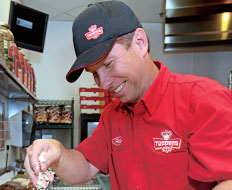With the media and industry experts touting the importance of executive transparency, many brands and leaders are placing a greater emphasis on being open both with their staff and customers. But while the definition of transparency may seem as simple as being honest about actions and motivations, putting it into practice in the quick-service and fast-casual environment can be complex and challenging, especially when it comes to striking the balance between oversharing and secrecy.
The benefits of CEO transparency differ between employees and customers, says Mike Husman, an executive coach with business-consulting firm The Entrepreneur’s Source. Customers, he says, want to know whom they are dealing with, what makes a company tick, and a brand’s future plans—all things that a CEO can help influence.
“Transparency can make customers say, ‘Wow, this restaurant really wants to be successful and they really do have my best interests,’” Husman says. “When I have a decision of where to eat, I am more likely to go to the restaurant that I feel has my best interests at heart.”
Though a CEO may want to protect the reputation of his or her brand at all costs, Husman says, sharing shortcomings and how the company is working to improve in those areas can be beneficial. One quick-serve brand Husman worked with often had long waits at lunch; it routinely heard from customers that they did not visit because they were late getting back to work. The executive team set a goal of 30-second drive-thru transactions, setting up a timer in stores that revealed its average serve times to customers.
“When we started, [transaction times were] over a minute and 30 seconds, but as the weeks went on, the customers could visually see the wait times going down,” Husman says. “Sales increased substantially because of this effort, and then customers would now see a long line and feel confident that the line would move quickly enough to make it back to work on time.”
In the unfortunate case of an accident, like sickness from a restaurant’s food or a scandal that creeps up, honesty from the CEO is always the best policy, Husman says.
“Being as open as possible about it is the best thing you can do,” he says. “If you can get approval from your lawyers to at least get that out and not try to cover it up, that transparency is really going to work for you in the long run—especially if they know in the same breath that you’re giving responses that this is what you’re doing to resolve that problem and it will never happen again.”
Just as transparency with guests creates a better customer experience, sharing information with employees helps a chief executive form a team environment where they feel their contributions are important to the overall success of the brand, says Dave Shula, president of Shula Burger.
“If you hire talented people, you want them to contribute to the best of their ability. To get this level of commitment from them, they need to understand what the brand is trying to accomplish, so you need to treat them as stakeholders in the company by sharing information and letting them know how their decisions impact the success,” he says.
Without placing an emphasis on transparency, brands and leaders risk creating a team of employees that isn’t focused on the concept’s primary goals, says Scott Gittrich, CEO of Toppers Pizza. He says companies that want to form a strong team across the board attract the best candidates by being open and honest. “Entrepreneurs are successful when people buy into their vision,” he says. “And the only way for someone to really share your vision is to be transparent.”
Though there are several benefits to being open with employees and guests, there is also the danger of sharing too much and too often, which can cause an executive to lose trust with stakeholders in cases that they don’t understand the context of the situation. Husman recommends leaders keep salary information, along with other human resource details, as private as possible to respect all parties involved.
Proprietary food information shouldn’t be revealed either, Shula says. “With our customers, we share as much as we can, with the exception of the blending of our beef,” he says. “We tell them it is Angus beef and the same grade we serve in our steakhouses, but we don’t tell customers our formula.”
Often, CEOs also have questions about whether to share financial information with employees, Husman says. But since employees often do not understand financial data, leaders who share this information must clearly communicate what the numbers mean and educate the employees on the financial logistics, he says.
“If a business simply tells employees that their revenues were $5 million, then staff may get the impression that they are not being paid enough because the company is making so much money,” Husman says. “You have to take the time to explain that just because you have $5 million in revenue, it doesn’t all fall to the bottom line.”
Shula Burger, however, shares all of its financial data with employees to help them see the progress the brand is making toward revenue goals, which affects employee bonuses. “We want them to see our progress to help them understand how their decisions affect the company, the bottom line, and their bonuses,” Shula says.








